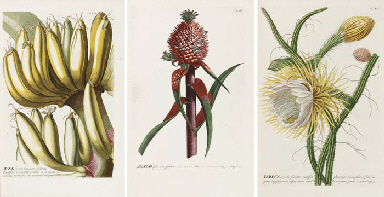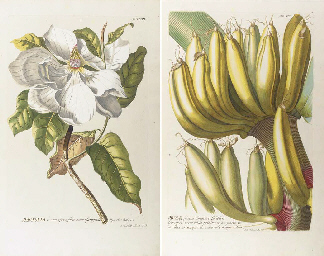TREW, Christoph Jakob (1695-1769), and Benedict Christian VOGEL (1745-1825). [ Plantae Selectae . Nuremberg]: 1750-1773. 10 parts in one volume, large 2° (524 x 365mm). 3 mezzotint portraits of Trew, G.D. Ehret and J.J. Haid, 10 engraved section titles, heightened in red and gold, manuscript part numbers in ink, 100 hand-coloured engraved plates by Johann Jacob Haid and Johann Elias Haid after Georg Dionysius Ehret each with the first word of the caption heightened in gold, extra-illustrated with calligraphic manuscript title in French bound at the front. (Without the engraved general title.) Contemporary German mottled calf gilt, covers with triple fillet border, spine in eight compartments with raised bands, red morocco lettering-piece in the second, the others with repeat decoration of stylised foliage and small tools, comb-marbled endpapers, g.e. (extremities scuffed, spine chipped at head and foot, joints splitting). ONE OF THE GREATEST EIGHTEENTH-CENTURY BOTANICAL WORKS, Trew's Plantae Selectae is illustrated with Ehret's matchless plates, which, according to Hunt, achieve "realism, majesty, ineffable color, all in one breathtaking look". This copy is apparently an early issue, without the general title issued in about 1773, but with all the parts titles and a fine contemporary calligraphic manuscript title (in French) bound at the front. This work received extravagant and richly-deserved contemporary praise, with no less an authority than Linnaeus himself writing to Trew that "The miracles of our century in the natural sciences are your work of Ehret's plants, Edward's work of birds and Roesel's of insects, nothing to equal them was seen in the past or will be in the future". Born in Heidelberg in 1710, Georg Dionysius Ehret originally worked as a gardener, practicing drawing in his spare time. His artistic abilities led him into the service of a Regensburg banker named Leskenkohl who commissioned him to copy plates from van Rheede tot Draakestein's Hortus indicus malabaricus (1678-1703). It was during this period that he met Trew, a physician and amateur botanist, who became a loyal friend and patron. Ehret moved to London in the late 1730s, where he painted many of the recently introduced exotics at the Chelsea Physic Garden and established himself as a teacher of flower-painting and botany. By 1742 publication of the Plantae selectae was already planned. Trew wrote to Christian Thran in Carlsruhe to say: "Every year I receive some beautifully painted exotic plants [by Ehret] and have already more than one hundred of them, which with other pieces executed by local artists, should later on ... constitute an appendicem to Weinmann's publication" (Gerta Calman, Georg Ehret, Flower Painter Extraordinary , 1977, p. 97.) Discussions about the projected work continued by letter until 1748 when Johann Jacob Haid from Augsburg agreed to produce the engravings from Ehret's drawings. The first part was published in 1750, with the six subsequent parts appearing before Trew's death in 1769. The text to the final three parts remained unwritten and the plates to parts IX and X were still to be produced. The work was brought to a conclusion by Benedict Christian Vogel Professor of Botany at the University of Altdorf. Dunthorne 309; Great Flower Books (1990) p.144; Hunt 539; Nissen BBI 1997; Pritzel 9499; Stafleu & Cowan 15.131.
TREW, Christoph Jakob (1695-1769), and Benedict Christian VOGEL (1745-1825). [ Plantae Selectae . Nuremberg]: 1750-1773. 10 parts in one volume, large 2° (524 x 365mm). 3 mezzotint portraits of Trew, G.D. Ehret and J.J. Haid, 10 engraved section titles, heightened in red and gold, manuscript part numbers in ink, 100 hand-coloured engraved plates by Johann Jacob Haid and Johann Elias Haid after Georg Dionysius Ehret each with the first word of the caption heightened in gold, extra-illustrated with calligraphic manuscript title in French bound at the front. (Without the engraved general title.) Contemporary German mottled calf gilt, covers with triple fillet border, spine in eight compartments with raised bands, red morocco lettering-piece in the second, the others with repeat decoration of stylised foliage and small tools, comb-marbled endpapers, g.e. (extremities scuffed, spine chipped at head and foot, joints splitting). ONE OF THE GREATEST EIGHTEENTH-CENTURY BOTANICAL WORKS, Trew's Plantae Selectae is illustrated with Ehret's matchless plates, which, according to Hunt, achieve "realism, majesty, ineffable color, all in one breathtaking look". This copy is apparently an early issue, without the general title issued in about 1773, but with all the parts titles and a fine contemporary calligraphic manuscript title (in French) bound at the front. This work received extravagant and richly-deserved contemporary praise, with no less an authority than Linnaeus himself writing to Trew that "The miracles of our century in the natural sciences are your work of Ehret's plants, Edward's work of birds and Roesel's of insects, nothing to equal them was seen in the past or will be in the future". Born in Heidelberg in 1710, Georg Dionysius Ehret originally worked as a gardener, practicing drawing in his spare time. His artistic abilities led him into the service of a Regensburg banker named Leskenkohl who commissioned him to copy plates from van Rheede tot Draakestein's Hortus indicus malabaricus (1678-1703). It was during this period that he met Trew, a physician and amateur botanist, who became a loyal friend and patron. Ehret moved to London in the late 1730s, where he painted many of the recently introduced exotics at the Chelsea Physic Garden and established himself as a teacher of flower-painting and botany. By 1742 publication of the Plantae selectae was already planned. Trew wrote to Christian Thran in Carlsruhe to say: "Every year I receive some beautifully painted exotic plants [by Ehret] and have already more than one hundred of them, which with other pieces executed by local artists, should later on ... constitute an appendicem to Weinmann's publication" (Gerta Calman, Georg Ehret, Flower Painter Extraordinary , 1977, p. 97.) Discussions about the projected work continued by letter until 1748 when Johann Jacob Haid from Augsburg agreed to produce the engravings from Ehret's drawings. The first part was published in 1750, with the six subsequent parts appearing before Trew's death in 1769. The text to the final three parts remained unwritten and the plates to parts IX and X were still to be produced. The work was brought to a conclusion by Benedict Christian Vogel Professor of Botany at the University of Altdorf. Dunthorne 309; Great Flower Books (1990) p.144; Hunt 539; Nissen BBI 1997; Pritzel 9499; Stafleu & Cowan 15.131.






.jpg)
.jpg)






Testen Sie LotSearch und seine Premium-Features 7 Tage - ohne Kosten!
Lassen Sie sich automatisch über neue Objekte in kommenden Auktionen benachrichtigen.
Suchauftrag anlegen